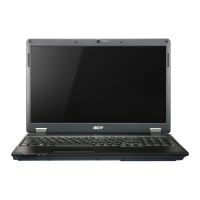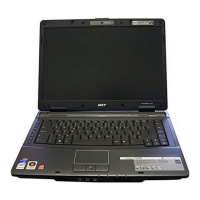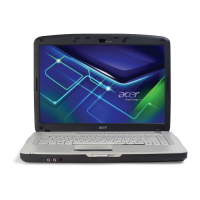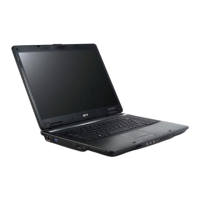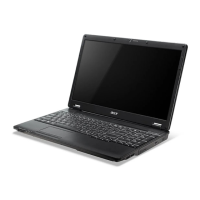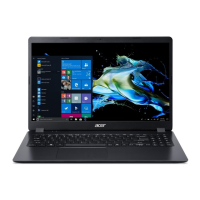Why my Acer Laptop doesn’t power off?
- DderrickwardJul 29, 2025
If your Acer Laptop doesn’t power off, press and hold the power switch for more than 4 seconds.
Why my Acer Laptop doesn’t power off?
If your Acer Laptop doesn’t power off, press and hold the power switch for more than 4 seconds.
Why does my Acer Extensa 5630 Laptop memory count appear different from actual size?
If the memory count size appears different from the actual size on your Acer Laptop, enter the BIOS Setup Utility to execute “Load Default Settings”, then reboot the system.
Summary of the computer's main features, including platform, memory, display, storage, keys, and audio.
Details about the processor technology and wireless connectivity options.
Information regarding RAM type, speed, capacity, and module compatibility.
Specifications for the LCD screen resolution and graphics chipset details.
Details on hard disk drive options and optical drive types available.
Description of special keyboard keys, touchpad, and hotkeys.
Information on built-in stereo speakers and audio support features.
Details on video conferencing, WLAN, WPAN, LAN, and modem connectivity.
List and description of various input/output connectors on the computer.
Operating temperature and humidity specifications for the system.
Identification of components visible on the notebook's front panel.
Identification of ports and switches located on the closed front of the notebook.
Identification of ports and connectors on the left side of the notebook.
Identification of ports and features on the right side of the notebook.
Identification of ports and ventilation slots on the rear of the notebook.
Identification of components and access panels on the underside of the notebook.
Explanation of the computer's status indicator lights.
Description of special function keys for quick application access.
Instructions on using the touchpad, including fingerprint reader functionality.
Details on keyboard functions, including lock keys and embedded numeric keypad.
Explanation of keys with Windows-specific shortcut functions.
Description of key combinations for quick system control and function access.
Overview of Acer's utility for system management and optimization.
Utility for configuring power management options and optimizing battery life.
Utility for protecting data with passwords and encryption.
Utility for backing up and restoring system data and applications.
Utility for inspecting hardware specifications and modifying boot options.
Tool for quickly configuring mobile-related system settings.
Introduction to various system utility software for enhanced functionality.
Utility for managing multiple display configurations and window arrangements.
Detailed specifications of the CPU, fan, and cooling system.
Information regarding the BIOS vendor and version number.
Specifications for system memory modules, including type, speed, and capacity.
Table detailing possible RAM configurations using available slots.
Specifications for the local area network interface controller.
Details regarding the Bluetooth module's chipset and protocol.
Specifications for the wireless network interface module.
Specifications for various hard disk drive models and their interfaces.
Specifications for the optical drive and supported media formats.
Details on the audio controller, resolution, and sound capabilities.
Specifications for the graphics memory chipset and size.
List of key integrated circuits and their controllers on the motherboard.
Specifications for the keyboard controller and layout.
Information on battery type, capacity, cell count, and configuration.
Detailed specifications for the 15.4-inch LCD panel, including resolution and brightness.
Specifications for the AC power adapter, including input and output ratings.
Explanation of ACPI power states and system power management features.
Guide to accessing and using the BIOS configuration program.
Instructions on moving through BIOS menus and changing parameter values.
Details on viewing system hardware information within the BIOS setup.
Explanation of settings related to system time, date, and boot options.
How to set up BIOS passwords for system access and protection.
Step-by-step guide to setting supervisor, user, and HDD passwords.
Configuration of boot device order and boot-related options.
Options for saving or discarding BIOS changes and exiting the setup utility.
Procedure for updating the system BIOS firmware.
Methods for removing HDD and BIOS passwords.
Tools and precautions needed before disassembling the computer.
Important notes and instructions before starting the disassembly process.
Step-by-step guide for removing external components of the notebook.
Procedure for safely removing the notebook's battery.
Steps to remove the SD card dummy module.
Steps to remove PC and ExpressCard dummy modules.
Instructions for removing the bottom casing of the laptop.
Procedure to remove or replace system memory modules.
Steps for removing the wireless network interface card.
Procedure for removing the computer's primary storage device.
Steps to remove the CD/DVD drive.
Guide to removing the cooling assembly for the CPU and VGA.
Detailed steps for removing and installing the central processing unit.
Procedure for removing the discrete graphics card.
Instructions for removing the entire display assembly.
Overall process for disassembling the main internal components of the notebook.
Steps to remove the internal mid-frame cover for access.
Procedure for removing the system's power supply board.
Steps to remove the laptop's keyboard assembly.
Procedure for removing the cooling fan assembly.
Steps to remove the internal audio speakers.
Procedure for removing the launch board.
Steps to remove the fingerprint reader and touchpad assembly.
Procedure for removing the internal modem.
Steps to remove the USB interface board.
Detailed procedure for removing the system's motherboard.
Step-by-step guide for disassembling the LCD assembly.
Steps to remove the frame surrounding the LCD screen.
Procedure for removing the LCD panel and its mounting brackets.
Steps to disconnect and remove the flexible flat cable.
Instructions for removing the LCD mounting brackets.
Steps to detach the wireless antennas from the display assembly.
Procedure for removing the built-in notebook camera.
Steps to perform system diagnostics for various components.
Procedure for testing the external diskette drive.
Procedure for testing the external CD-ROM drive.
Steps for testing the keyboard and other input devices.
Procedure for diagnosing potential memory errors.
Steps to verify power supply issues using battery and adapter.
Guide to testing the AC power adapter's output voltage.
Procedure for checking battery health and charging status.
Steps to troubleshoot issues with the touchpad.
Guide to interpreting BIOS POST error messages and their causes.
Comprehensive list of error codes, messages, and troubleshooting actions.
Table mapping BIOS beep patterns to POST routine descriptions.
Cross-reference of symptoms to potential Field Replaceable Units (FRUs).
Diagrams showing component locations on the motherboard.
Procedures for clearing BIOS passwords and recovering the BIOS firmware.
Steps to clear BIOS passwords using hardware jumpers.
Instructions for recovering BIOS using a crisis diskette.
List of parts that can be replaced in the field.
Visual representation of component assembly for part identification.
Detailed list of all field-replaceable units with part numbers.
Table detailing various system configurations and specifications by model.
Information on components tested and verified for system compatibility.
List of hardware tested in a Windows Vista environment.
List of PCMCIA cards tested for compatibility.
List of ExpressCards tested for compatibility.
List of various memory cards tested for compatibility.
Details on accessing online technical support and resources from Acer.
| Bus type | FSB |
|---|---|
| Stepping | M0 |
| Tjunction | 100 °C |
| FSB Parity | No |
| Processor cache | 1 MB |
| Processor cores | 2 |
| System bus rate | - GT/s |
| Processor family | Intel® Pentium® |
| Processor socket | LGA 3647 (Socket P) |
| Processor codename | Merom |
| Processing Die size | 143 mm² |
| Processor frequency | 2 GHz |
| Processor cache type | L2 |
| Processor lithography | 65 nm |
| Processor manufacturer | Intel |
| Processor front side bus | 667 MHz |
| Processor operating modes | 64-bit |
| Thermal Design Power (TDP) | 35 W |
| CPU multiplier (bus/core ratio) | 12 |
| Number of Processing Die Transistors | 291 M |
| Motherboard chipset | Intel® GL40 Express |
| Optical drive type | DVD±RW |
| Card reader integrated | Yes |
| Total storage capacity | 250 GB |
| Display surface | Matt |
| Display diagonal | 15.4 \ |
| Display resolution | 1280 x 800 pixels |
| Native aspect ratio | 16:10 |
| Type | PC |
| Modem speed | 56 Kbit/s |
| Dimensions (WxDxH) | 267 x 30.3 x 360 mm |
| Compliance industry standards | ACPI, DMI, Mobile PC2002, Wi-Fi CERTIFIED |
| Internal memory | 3 GB |
| Internal memory type | DDR2-SDRAM |
| CD write speed | 24 x |
| Trial software | McAfee Internet Security Suite |
| Bundled software | Acer Empowering Technology Acer GridVista Acer Launch Manager Adobe Acrobat Reader Corel WinDVD NTI Media Maker |
| Operating system installed | Windows Vista Home Premium |
| Battery life (max) | 2.5 h |
| Number of battery cells | 6 |
| Charging port type | DC-in jack |
| Serial ports quantity | 0 |
| USB 2.0 ports quantity | 3 |
| Cable lock slot type | Kensington |
| Password protection type | BIOS |
| Discrete graphics card model | Intel® GMA 4500MHD |
| Processor code | SLAVG |
| Processor ARK ID | 37160 |
| Depth | 30.3 mm |
|---|---|
| Width | 267 mm |
| Height | 360 mm |
| Weight | 2900 g |
